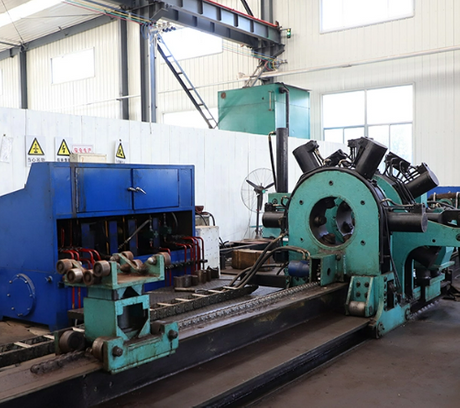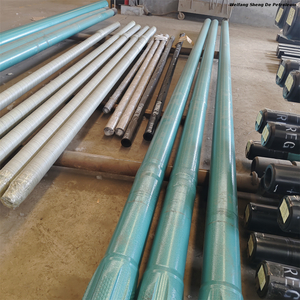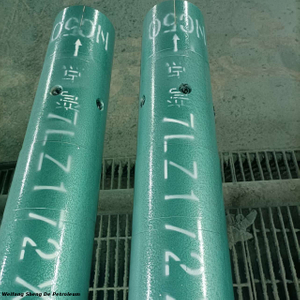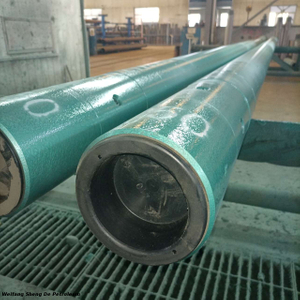Positive Displacement Motors (PDM), also known as mud motors, are essential in modern directional drilling. These motors convert hydraulic energy from drilling mud into mechanical power, allowing for precise rotation of the drill bit. This process enables efficient and controlled drilling, especially in challenging environments.
In this article, we'll dive into the key components and working principles of PDM motors. You'll discover how these motors enhance drilling performance, increase penetration rates, and provide stability for directional control.
What is a PDM Motor?
A Positive Displacement Motor (PDM), often referred to as a mud motor, is a critical tool in downhole drilling operations. It functions by converting the hydraulic energy from the drilling mud into mechanical energy, which is used to rotate the drill bit. This mechanical power allows the drill bit to cut through rock formations, enabling efficient drilling.
PDM motors play a vital role in directional drilling by providing consistent rotational power. This capability allows for precise control of the drill bit's movement, making it possible to drill at specific angles and navigate complex well paths. Their ability to maintain continuous rotation ensures steady progress, even in challenging drilling conditions.
Key Components of a PDM Motor
Power Section
The power section is the heart of a PDM motor. It consists of a rotor and stator assembly that work together to generate torque. The rotor, shaped like a helix, moves within the stator, which has a matching helical cavity. As drilling fluid flows through the motor, the pressure difference causes the rotor to rotate. This rotation transforms hydraulic energy into mechanical energy, which is then used to power the drill bit.
Bearing Section
Bearings are essential for the stability of the motor during drilling operations. They support the rotating parts and ensure smooth movement under high-pressure conditions. Common types of bearings used in PDM motors include roller bearings and ball bearings, both designed to reduce friction and enhance efficiency. These bearings help maintain precise rotation, even in tough drilling environments.
Housing and Shaft
The housing plays a crucial role by enclosing both the power and bearing sections. It provides the motor with structural integrity and protects the internal components from harsh downhole conditions. The shaft connects the power section to the drill bit, transferring rotational power and ensuring the bit turns efficiently. It must be durable enough to handle the forces and vibrations during drilling.
Stabilizers and Nozzles
Stabilizers help keep the drill bit straight during operation. By reducing wellbore deviation, they ensure the drill follows the intended path, especially in directional drilling. Nozzles are another important component. They help direct the flow of drilling fluid, keeping the motor cool and clearing debris from the drill bit. This constant flow of fluid enhances motor performance and prevents overheating.
Seals and O-rings
Seals and O-rings are vital for maintaining operational efficiency. They prevent leaks of drilling fluid, ensuring that the system remains sealed and pressurized. These components help reduce wear and tear on the motor, improving its lifespan and reliability. By sealing the system, they also maintain the correct fluid flow, which is critical for the motor's performance.
How Does a PDM Motor Work?
Conversion of Hydraulic Energy
The process begins when drilling mud, pumped down the drill string, enters the Positive Displacement Motor (PDM). This drilling fluid, typically a mixture of water, clay, and other additives, carries hydraulic energy that powers the motor. As the fluid enters the motor, it flows through the rotor and stator assembly, where it is converted from hydraulic energy into mechanical energy.
The motor's rotor and stator are designed with helical shapes that work in tandem. As drilling mud passes through the stator's helical cavity, it creates a change in volume. This change in volume generates pressure, and the fluid's pressure forces the rotor to turn. The helical rotor moves in the stator cavity, creating a "progressing cavity" effect that transforms hydraulic pressure into rotational mechanical power. This power is then transmitted to the drill bit, enabling it to cut through rock formations.
The efficiency of this conversion largely depends on the design of the rotor and stator. The rotor's unique shape and the stator's precise cavity geometry maximize the conversion of hydraulic pressure into torque, which is essential for the drilling operation.
Rotor and Stator Interaction
The heart of the PDM's function lies in the interaction between the rotor and stator. The rotor, which is typically a helical shaft, fits into a matching helical cavity inside the stator. The stator usually has one more lobe than the rotor, which is crucial for generating the rotational movement.
As the drilling mud flows through, the pressure difference between the inlet and outlet sections causes the rotor to rotate. The rotor's helical shape moves within the stator, generating torque as the rotor spins. This torque is the twisting force that drives the drill bit. Because the rotor and stator interact in a "positive displacement" manner, they ensure continuous and consistent rotation, making it possible to drill through challenging formations without losing momentum.
The number of lobes on both the rotor and stator affects the motor's performance. More lobes generally result in higher torque, ideal for heavy-duty drilling. Fewer lobes lead to faster rotation, which may be more suitable for softer formations. By adjusting these parameters, engineers can optimize the motor's performance for different drilling conditions.
![positive displacement motor positive displacement motor]()
Role of Mud Flow
Mud flow plays an integral role in the operation of the PDM motor. The drilling fluid, which is pumped under pressure, flows through the motor, creating a pressure difference between the motor's inlet and outlet. This difference in pressure is what drives the rotor's rotation.
The flow of mud through the stator and rotor assembly generates a force that pushes the rotor to turn. The pressure difference between the inlet and outlet also ensures that the rotor continues to rotate smoothly, providing steady power to the drill bit. As the mud flows through the motor, it flushes out the cuttings produced by the drill bit, preventing blockages and keeping the motor running efficiently.
This process creates a direct relationship between mud flow rate and motor speed. The more mud that flows through the motor, the faster the rotor rotates, and the higher the torque. The mud flow also helps to cool the motor and prevents it from overheating, a crucial factor in maintaining the motor's operational lifespan. Proper mud flow is essential for optimal motor performance, as any disruption in fluid flow can lead to a decrease in rotational power or even motor stalling.
In essence, the flow of drilling mud acts as both the energy source and cooling mechanism for the PDM motor. By controlling the flow rate, drilling operators can fine-tune the motor's speed and torque, ensuring efficient and precise drilling.
Factors Affecting PDM Motor Performance
Flow Rate
The flow rate of drilling fluid plays a critical role in the performance of a PDM motor. Higher flow rates generally increase the rotational speed of the motor and the torque it produces. The amount of fluid entering the motor determines how quickly the rotor moves within the stator. If the flow rate is too low, the motor may not generate enough power to turn the drill bit efficiently.
The viscosity and volume of the drilling fluid also affect performance. Thicker fluids (higher viscosity) can slow down the motor, while a higher flow volume can increase the torque and speed. The right balance ensures optimal motor operation in various drilling conditions.
Torque and Pressure Drop
Torque is generated by the pressure difference between the inlet and outlet of the PDM motor. As drilling fluid moves through the motor, it creates a pressure drop across the rotor and stator. This pressure difference is crucial for generating the mechanical energy that rotates the drill bit.
The relationship between torque and pressure drop is essential for the motor's efficiency. A larger pressure drop usually means higher torque, leading to better performance. However, if the pressure drop is too high, it may result in increased wear and potential motor failure. Properly managing the pressure drop ensures that the motor operates efficiently without causing damage.
Number of Lobes and Stages
The number of lobes on the rotor and stator has a direct impact on the motor's performance. More lobes increase the torque output, as the rotor meshes more precisely with the stator. A higher lobe count means more contact points, generating greater force. However, it may also slow down the rotational speed.
The number of stages, or twists, in the stator, also influences the motor's power. Multiple stages allow for higher horsepower and more efficient energy transfer. Motors with more stages are typically used in applications requiring higher torque and power. Conversely, motors with fewer stages are better for tasks requiring faster rotations, though they may generate less torque.
The configuration of lobes and stages helps to tailor the motor for specific drilling needs, balancing speed and power for different conditions.
Maintenance and Troubleshooting of PDM Motors
Proper maintenance of a PDM motor is essential to ensure its longevity and maintain high efficiency during drilling operations. Regular upkeep helps prevent costly downtime and ensures the motor performs at its best. Some basic maintenance tasks include:
Cleaning and Inspection: Regularly check the motor components, especially the rotor and stator, for wear or damage. Keep the motor clean and free of debris.
Lubrication: Ensure that all moving parts, such as bearings and the rotor, are well-lubricated to reduce friction and wear.
Seals and O-rings: Inspect and replace seals and O-rings to prevent fluid leaks, which can lead to motor failure.
Check for Leaks: Regularly check the motor's housing for any signs of leakage, especially around the seals.
Despite proper maintenance, issues may still arise. Troubleshooting common problems is vital to minimize operational delays. Here are some common issues and solutions:
Stalling Due to High Differential Pressure: If the motor stalls, it may be due to excessive pressure differences within the motor. This typically happens when the motor's internal cavities become blocked or there's insufficient flow of drilling fluid. Ensure the mud flow is adequate and check for any blockages in the system. Reducing the pressure difference can prevent stalling.
Motor Failure: Motor failure can occur due to several reasons, including worn-out bearings, damaged stator or rotor, or poor maintenance practices. In case of motor failure, perform a thorough inspection of the key components and replace damaged parts. It's crucial to keep track of the motor's performance regularly to identify early signs of failure before it becomes a major problem.
By following proper maintenance procedures and troubleshooting common issues, PDM motors can operate efficiently, ensuring smooth and uninterrupted drilling operations.
![positive displacement motor positive displacement motor]()
Conclusion
Positive Displacement Motors (PDMs) are essential in directional drilling, converting hydraulic energy into mechanical power. They provide precise rotational control, enabling efficient drilling, especially in challenging conditions. Regular maintenance and troubleshooting are key to keeping PDM motors running smoothly, ensuring they remain effective and reliable throughout operations.
FAQ
Q: What is the main function of a PDM motor?
A: A PDM motor, or Positive Displacement Motor, converts hydraulic energy from drilling fluid (mud) into mechanical power to rotate the drill bit. It enables efficient directional drilling, especially in deviated or horizontal wells.
Q: What causes a PDM motor to stall?
A: A PDM motor can stall due to excessive differential pressure. This usually happens when the motor's internal cavities are blocked or when there is insufficient flow of drilling fluid, preventing proper movement and rotation.
Q: How can I maintain a PDM motor?
A: Regular maintenance tasks include cleaning, lubrication, and inspecting components like the rotor, stator, and bearings. Replacing seals and O-rings and checking for fluid leaks also helps ensure the motor's efficiency and longevity.



















